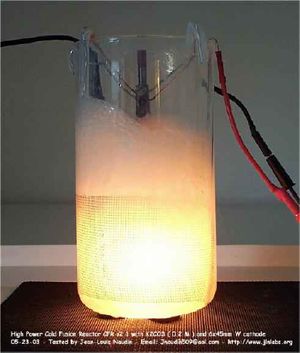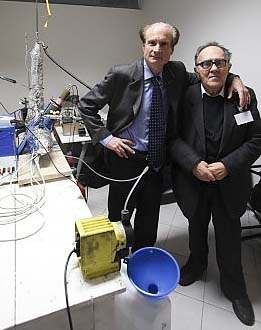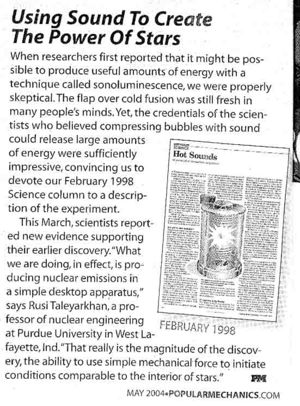Difference between revisions of "Cold Fusion"
(Created page with 'thumb '''Cold Fusion''' is a term used for controlled nuclear transformations, which take place outside of fusion reactors. Such processes are rare and …') |
|||
| Line 9: | Line 9: | ||
==Rossi-Energy-Catalyzer / Piantelli-Focardi-Rossi-Experiments== | ==Rossi-Energy-Catalyzer / Piantelli-Focardi-Rossi-Experiments== | ||
[[image:Rossi_Focardi.jpg|Andrea Rossi und Sergio Focardi (Bild "La Repubblica")|thumb]] | [[image:Rossi_Focardi.jpg|Andrea Rossi und Sergio Focardi (Bild "La Repubblica")|thumb]] | ||
| − | The [[Focardi-Rossi Energy-Catalyzer]] is an alleged compact fusion reactor based on an assumed Cold Fusion technology which is planned to be brought to market in 2011 by the Italian company EON Srl. While allegedly using no more than several hundred Watts in electrical heating energy, it is said to emit a heat output capacity of more than 10 kW. According to Italian inventors Sergio Focardi and Andrea Rossi cold fusion of hydrogen and nickel was taking place in the reactor, leading to the formation of copper. As a side-effect of the reaction, ionizing radiation is said to be emitted, which was disproved by independent parties. | + | The [[Focardi-Rossi Energy-Catalyzer]] is an alleged compact fusion reactor based on an assumed Cold Fusion technology which is planned to be brought to market in 2011 by the Italian company EON Srl. While allegedly using no more than several hundred Watts in electrical heating energy, it is said to emit a heat output capacity of more than 10 kW. According to Italian inventors Sergio Focardi and Andrea Rossi cold fusion of hydrogen and nickel was taking place in the reactor, leading to the formation of copper. As a side-effect of the reaction, ionizing radiation is said to be emitted, which was disproved by independent parties. So far, attempts to replicate the experiment independently failed. The latest (partially public) presentations took place from mid-January to end of March 2011. |
==Aqua Flame== | ==Aqua Flame== | ||
Revision as of 19:52, 10 April 2011
Cold Fusion is a term used for controlled nuclear transformations, which take place outside of fusion reactors. Such processes are rare and not useful for producing noteworthy amounts of energy or relevant fusion products. It is known since 1978 that muons can trigger such fusion processes. But the generated amount of energy is insufficient to enable a chain reaction. Theoretical considerations to muon-catalysed fusion processes were already done in the 1940s by F. C. Frank and Andrej Sacharov.[1]
Muon-catalysed fusion has no practical appliance.
Fleischmann and Pons 1989
In 1989 the researchers Martin Fleischmann and Stanley Pons claimed to have accomplished cold fusion through an electrochemical process and received wide coverage by press, which led to a popularization of the term. Hopes for a sensational new eneergy source were fuelled. The Fleischmann-Pons-experiment, which showed a small energy release, could not be replicated. The authors themselves were later unable to reproduce their experiment successfully. In this experiment hydrogen should have been fused through electrolysis of an electrolyte at the surface of two palladium-electrodes. Basically, this should have produced energy from water.[2]
Rossi-Energy-Catalyzer / Piantelli-Focardi-Rossi-Experiments
The Focardi-Rossi Energy-Catalyzer is an alleged compact fusion reactor based on an assumed Cold Fusion technology which is planned to be brought to market in 2011 by the Italian company EON Srl. While allegedly using no more than several hundred Watts in electrical heating energy, it is said to emit a heat output capacity of more than 10 kW. According to Italian inventors Sergio Focardi and Andrea Rossi cold fusion of hydrogen and nickel was taking place in the reactor, leading to the formation of copper. As a side-effect of the reaction, ionizing radiation is said to be emitted, which was disproved by independent parties. So far, attempts to replicate the experiment independently failed. The latest (partially public) presentations took place from mid-January to end of March 2011.
Aqua Flame
Aqua Flame is a fusion project of the German company Purratio AG. Since Purratio refers in their principle to deuterium and palladium, it seems to be an application of the failed experiments of Fleischmann and Pons (1989).
Further Methods
Further methods are:
- Pyrofusion (without practical relevance)
- Sonofusion (or Bubble fusion, obviously data falsification)
Biological Transmutation
Biological Transmutation is hypothetically defined as a nuclear transmutation occurring in a living organism. There are no proofs for the existence of such transformations.
References
- ↑ Muon-catalyzed fusion in Wikipedia
- ↑ Browne, M. (May 3, 1989), "Physicists Debunk Claim Of a New Kind of Fusion", New York Times, retrieved 2011-05-10


